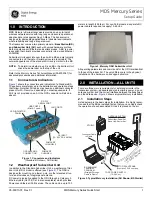
Document No. 563-202
Installation Instructions
March 12, 2008
Information in this publication is based on current specifications. The company reserves the right to make changes in specifications and
models as design improvements are introduced. Other product or company names mentioned herein may be the trademarks of their
respective owners. © 2008 Siemens Building Technologies, Inc.
Siemens Building Technologies, Inc.
1000 Deerfield Parkway
Buffalo Grove, IL 60089-4513
U.S.A.
Your feedback is important to us. If you have
comments about this document, send them to
.
Document No. 563-202
Country of Origin: US
Page 4 of 4
FCC Notes
This device complies with Part 15 of the FCC Rules.
Operation is subject to the following two conditions:
1. This device may not cause harmful
interference.
2. This device must accept any interference
received, including interference that may cause
undesired operation.
Changes or modifications not expressly approved by
the party responsible for compliance could void the
user’s authority to operate the equipment.
To comply with FCC’s RF exposure limits for general
population/uncontrolled exposure, the antenna(s)
used for this transmitter must be installed to provide
a separation distance of at least 20 cm from all
persons and must not be co-located or operating in
conjunction with any other antenna or transmitter.
FCC Interference Statement (Part 15.105 (b))
This equipment has been tested and found to
comply with the limits for a Class B digital device,
pursuant to Part 15 of the FCC Rules. These limits
are designed to provide reasonable protection
against harmful interference in a residential
installation. This equipment generates uses and can
radiate radio frequency energy and, if not installed
and used in accordance with the instructions, may
cause harmful interference to radio communications.
However, there is no guarantee that interference will
not occur in a particular installation. If this equipment
does cause harmful interference to radio or
television reception, which can be determined by
turning the equipment off and on, the user is
encouraged to try to correct the interference by one
of the following measures:
•
Reorient or relocate the receiving antenna.
•
Increase the separation between the
equipment and receiver.
•
Connect the equipment into an outlet on a
circuit different from that to which the
receiver is connected.
•
Consult the dealer or an experienced
radio/TV technician for help.
Industrie Canada Certification
This device has been designed to operate with an
antenna having a maximum gain of 5dBi. An
antenna having a higher gain is strictly prohibited
per regulations of Industry Canada. The required
antenna impedance is 50
Ω
.
To reduce potential radio interference to other users,
the antenna type and its gain should be so chosen
that the equivalent isotropically radiated power
(EIRP) is not more than that required for successful
communication.
The Wireless Transceiver Tool (TLX) is to be
installed or replaced by professional installation
personnel only.
DGT Interference Statement (Taiwan)
經型式認證合格之低功率射頻電機,非經許可,公司
、商號或使用者均不得擅自變更頻率、加大功率或變
更原設計之特性及功能。低功率射頻電機之使用不得
影響飛航安全及干擾合法通信;經發現有干擾現象時
,應立即停用,並改善至無干擾時方得繼續使用。前
項合法通信,指依電信法規定作業之無線電通信。低
功率射頻電機須忍受合法通信或工業、科學及醫療用
電波輻射性電機設備之干擾。
According to "Administrative Regulations on Low
Power Radio Waves Radiated Devices" Without
permission granted by the DGT, any company,
enterprise, or user is not allowed to change
frequency, enhance transmitting power or alter
original characteristic as well as performance to a
approved low power radio-frequency devices. The
low power radio-frequency devices shall not
influence aircraft security and interfere legal
communications; If found, the user shall cease
operating immediately until no interference is
achieved. The said legal communications means
radio communications is operated in compliance
with the Telecommunications Act. The low power
radio-frequency devices must be susceptible with
the interference from legal communications or ISM
radio wave radiated devices.






















